Olympic Champion Fanny Durack
Newcastle Ocean Baths
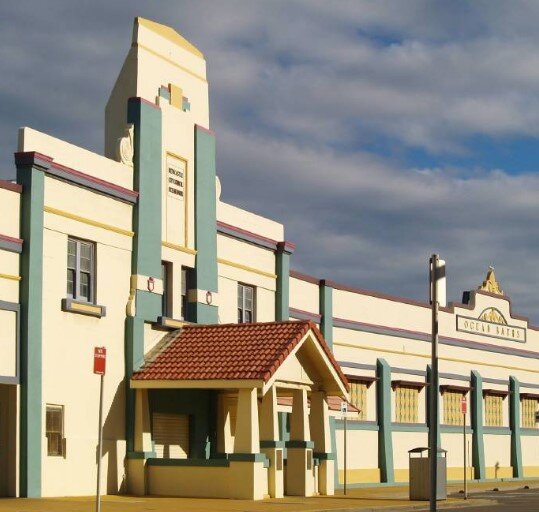
Generations of Novocastrians have walked through the unique art-deco facade pictured on the left to enter the refreshing, safe, popular swimming pool beyond known as the Newcastle Ocean Baths. This unique pool has enjoyed a special place in the hearts of children and adults alike for over one hundred years however few would recall now that it was also the scene of a famous world record breaking feat by one of Australia's great swimming champions.
Champion Swimming Carnival
In Australia in March 1915 during those first few months of the War To End All Wars the carnage of Gallipoli was still a month off and the first A.N.Z.A.C. Day ceremony, a year away. Although many families had farewelled their sons, brothers and friends, the harshest of the realities of war were yet to be realised. Many hoped those young soldiers they had bid adieu a short time before would return home by Christmas.Some sporting events and amusements still took place at this time despite the shadow of war. In Newcastle one of the events organised at the Ocean Baths was a visit from famous Hawaiian swimmer and surfing pioneer Duke Kahanamoku who performed an exhibition there in February 1915
Then one month later a Championship Swimming Carnival was held attracting competitors from the Sydney swimming clubs. The day was organised by the Premier Amateur Swimming Club on Saturday afternoon 27 March 1915.
Construction on the Newcastle Ocean Baths had commenced around 1911. They were opened to the public on the 1st of January 1913 for the first time however were not quite complete when this Carnival took place in March 1915.
An article in the Newcastle Herald described the event:
The weather was delightfully fine, and there was a very large attendance both on the island, and in the reserved enclosure. The surrounding slopes were also packed, and the promenades were well patronised by those people who prefer to view the proceedings from outside the enclosure. An attractive programme was provided, and most of the events were run off well to time.
Some of the officials present included the honorary secretary, Mr. R. Thomas; president Mr. T. Blackall ; starters Messrs S. Staton and R. Thomas; judges Messrs R. C. Pogonoski, J. Wiggins, J. Brinkley, H. McAlister, H.J. Robinson; timekeepers Messrs W. E. Gilkes, T. Blackall, R. Thomas, J. T. Canning; referee Mr. C. H. Tonkin.
Although the baths were still incomplete the enthusiasm and 'push' of these club members who never missed an opportunity of improving the club and encouraging the sport ensured the club's presence was renowned in the amateur swimming world.
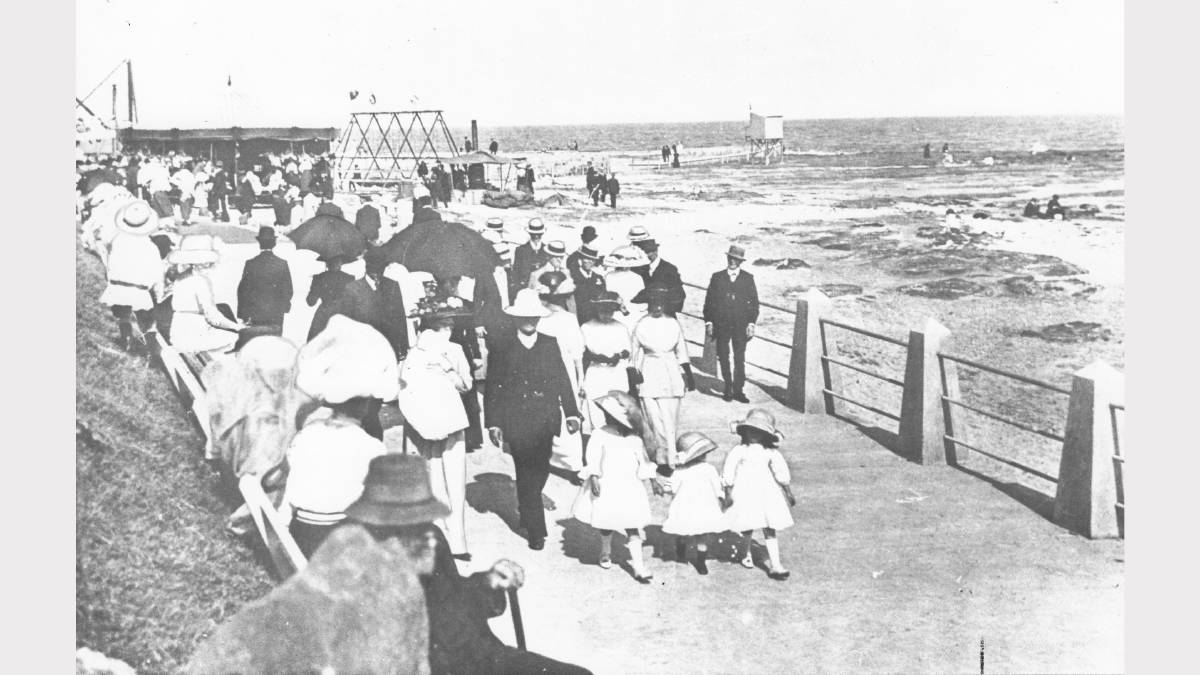
Above: Newcastle Ocean Baths and Promenade - Newcastle Herald (The attire of the women and children appears to be pre-war or early war years)
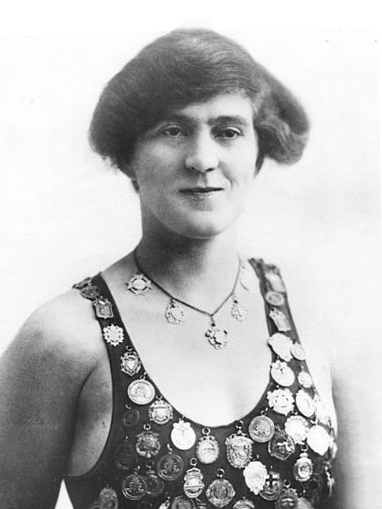
This fabulous photograph is of Fanny Durack with her medals on display
Fanny Durack
A remarkable and long-forgotten episode of Newcastle's history transpired at the Ocean Baths at the above mentioned swimming carnival - Miss Fanny Durack, the world's female champion swimmer, took on the task of lowering the world record for 500 yards, held by Miss Vera Neave of England, time of 7 minutes, 52 seconds.Sarah Frances 'Fanny' Durack was born on 27 October 1889 in Sydney. She had learned to swim in Coogee Baths using breast stroke reportedly after almost drowning at Newcastle beach. Before long she had perfected the stroke that would become known as the Australian Crawl (now commonly known as freestyle). From 1910 until 1918 she was the world's greatest female swimmer across all distances from freestyle sprints to the mile marathon.
An account of the race at Newcastle Ocean Baths was published in the Newcastle Herald:
As soon as the word was given, Miss Durack settled down to her task, and swimming a powerful stroke throughout, succeeded in covering the distance in 7 minutes 32 3/5 seconds, thus defeating the previous best by 19 2/3 seconds. It was a great effort, and the fair swimmer was loudly cheered when the announcement was made that she had created new figures for the distance. Later in the afternoon Fanny Durack gave an exhibition of fancy swimming which was much appreciated." [1]
Her presence at the Newcastle baths that day in March 1915 would have encouraged attendance of many of the townsfolk of Newcastle as well as enthusiasts from further afield.
Image: Emily and Iris Cotterill of Newcastle. Photographer Alfred Boddy of Newcastle
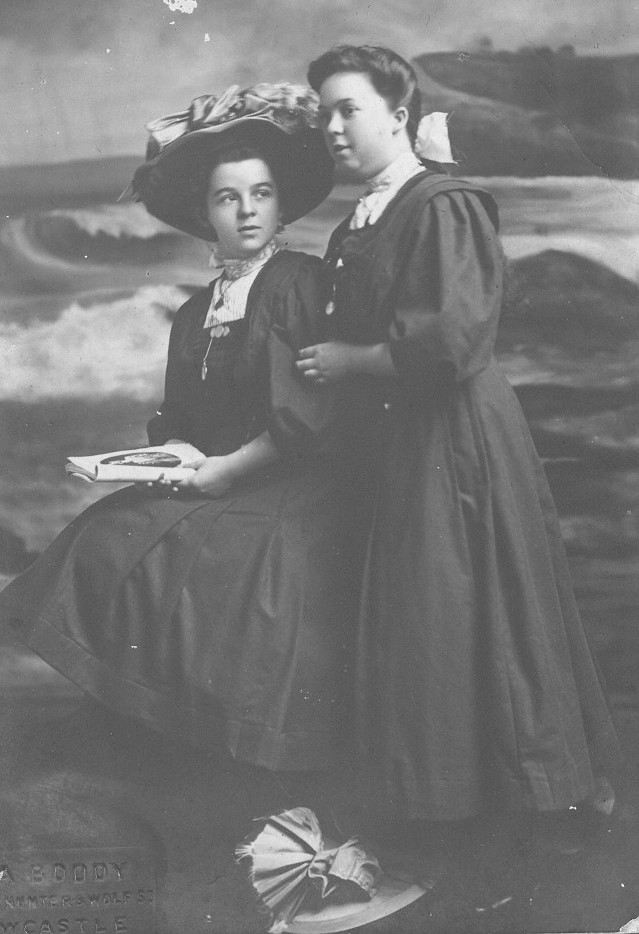
Transport to the Baths
Those attending would have travelled by foot, bicycle, carriage, train or tram.My grandmother Iris Cotterill was born in Newcastle in 1891 just eighteen months after the birth of Fanny Durack in Sydney. In 1915 when the Swimming Carnival took place my grandmother lived in Hunter-street West Newcastle and managed her father's butcher's business nearby. The family attended public and sporting events and sometimes performed at fund raisers for the Benevolent Society. As the war effort gathered pace my grandmother helped organise events to raise money and also sent many comfort parcels to soldiers in France and elsewhere. Publicly minded, it is easy to imagine that she may have been one of the many who attended this momentous event at the Newcastle Baths in March 1915. Like many others she may have travelled to the Newcastle Ocean Baths by tram. It would have been a steam tram if she had as the system was not electrified until December 1923.
My grandmother could have boarded the tram in Hunter-street and it would take her up to the Hunter-street / Scott-street merge and from there continued up Scott-street to the headland and Parnell Place tram terminus (formerly the site of Old Gaol Hill). Here she could have alighted and it was just a short walk to the Ocean Baths where the event took place.
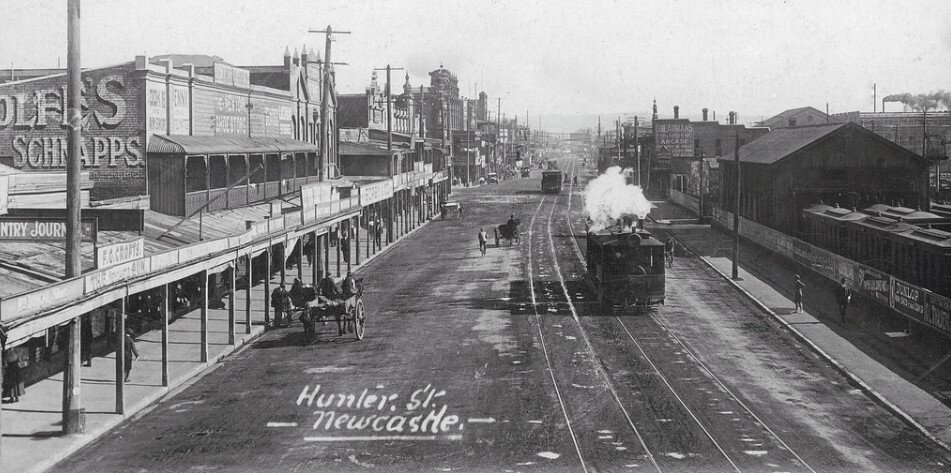 Steam Tram in Hunter Street - Newcastle Region Library
Steam Tram in Hunter Street - Newcastle Region Library
Return to Newcastle
Fanny Durack returned to Newcastle in 1916 and again in 1917 at the invitation of the Newcastle Amateur Surf Swimming Club. Her attempt to improve her own world record for the 200 yard swim proved unsuccessful, however she also raced against local swimmers in a handicap 50 yards race. Afterwards her display of trick and fancy swimming proved popular.Fanny Durack retired from competitive swimming in January 1921. After marrying Bernard Martin Gately, a horse-trainer later that month, she devoted herself to coaching young children. She died of cancer at her home at Stanmore on 20 March 1956 and was buried in the Catholic section of Waverley cemetery [3]
1922 Renovation
The dressing sheds at the Ocean Baths were not completed until 1918 and were completely updated in 1922.On the occasion of the opening of the new buildings by Alderman H. P. Cornish, Mayor in 1922 the Newcastle Herald gave a brief history of the baths and dressing sheds:
The dressing accommodation, which was built in 1918 has been supplanted entirely by two buildings the overall dimensions of which are 300ft, and the width 40ft. The materials used in the construction is reinforced concrete, and the whole is supported by piers carried down to the original rock. The western side of the building has been louvred, which adds to their appearance, and will prevent the uplifting of the roof by the strong winds and gales that not infrequently prevail about the coast. With these additions, the baths are probably the finest in the Commonwealth. The swimming area is certainly large than that of any other enclosed ocean baths in Australia, the exact rectangular dimensions being 300ft by 150ft, the depth varying from 2ft 9in to 9ft 6in. In giving a history of the baths, the Mayor stated that between 1911, the year in which the blasting of the rock as commenced, and 1913, Mr. L. B. Blackwell, then city engineer, had the bathing area prepared, and the wall and the side promenades constructed. Later, Mr. Adams had a pumping plant procured for filling the basin in calm weather. At the end of 1918, on the recommendation of Mr. J. F. Shine, city engineer, the rock pile was levelled off to make the island platform and a sluice channel, with automatic gate was built at the north-western end to reduce the sand accumulation. Other improvements were effected from time to time, and the growing popularity of the baths induced the council to go ahead with the comprehensive scheme which has just been completed.
On the approval of the designs last year the Mayor said the opportunity in the Government loan offered to carry out work that would help to relieve the industrial depression. The Government agreed to provide the funds, and tenders were called. The lowest was £3600. The City Engineer's estimate was £4500. This was approved, and the work was carried out by day labour at a cost of £5050, certain alterations having been effected in the course of construction.
Accommodation is provided for seven thousand people per day, this being the comfortable capacity of the baths, the filling of which with fresh ocean water is made amply secure by the provision of an electrically driven 12 inch centrifugal pump. The baths can be filled in four and a half hours with 1,200 gallons of water.
During the last season, it was felt that the cost of running the baths by the council was too heavy, and the margin of profit too small. The highest tenderers were Messrs Clayton and Moxey, their tendered rental being at the rate of 600 per annum. As the council had never realised anything near that sum in any year as net profit the tender was accepted. Few other bathing establishments had anything equal in the way of appointments. Refreshment rooms were provided, and there were spare rooms for clubs and gymnasiums.
A tablet bearing the name of the Aldermen who constituted the council of 1922 and those of Mr. J. Glassop, town clerk, and Mr. J. F. Shine, city engineer, was unveiled by the Mayor, who then declared the baths open. A programme of aquatic events controlled by the Northern District amateur Swimming Association was carried through, the officials being Messrs. R. R. Shaw, G. Fisher and J. Warland, judges; A. E. Vesper, J. Wiggins, and J. C. Morris, timekeepers; R. Thomas, starter; W. Owen and A. B. Caldwell, stewards. The Municipal Band, under the conductorship of Mr. H. E. Kerry, played selections during the afternoon. [2]
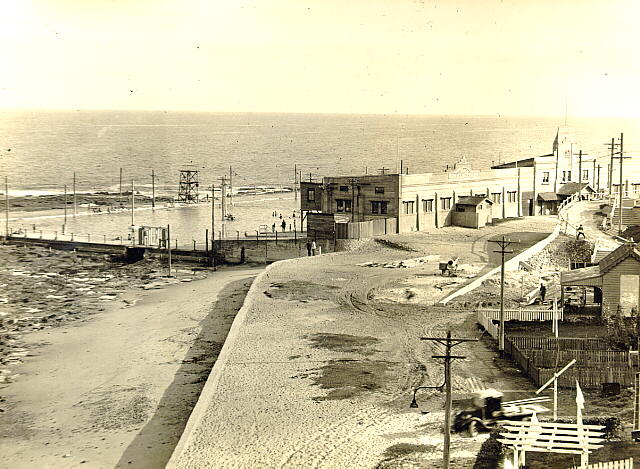 Above: Newcastle Baths 1930s - Hunter Photo Bank
Above: Newcastle Baths 1930s - Hunter Photo BankYoung Mariners Pool and Canoe Pool
The Canoe Pool next to the baths, originally known as the Young Mariners Pool, was built for children in 1930. One of the pool's features was a 20-metre-wide elliptical map of the world, jutting about 20 centimetres above the water during low tideNewcastle Ocean Baths Panorama c. 1937

References
[1]. Newcastle Morning Herald 29 March 1915[2] Newcastle Morning Herald 27 November 1922
[3] Helen King, 'Durack, Sarah (Fanny) (1889 - 1956)', Australian Dictionary of Biography, National Centre of Biography, Australian National University, published first in hardcopy 1981
↑
